The Cornell note-taking method was developed by Dr. Walter Pauk of Cornell University. This is a popular system for making notes during a lesson or reading, and for reviewing and memorizing that material. Using the Cornell system you can better sort your notes, learn concepts actively, improve your study skills and achieve academic success.
Steps
Part 1 of 4: Prepare the Sheets

Step 1. Dedicate sheets exclusively to notes to be taken with the Cornell method
Whether you decide to use a notebook, or you prefer loose sheets in a binder, you will need to dedicate pages exclusively to writing notes. You will need to divide each sheet into multiple sections, each with its own specific purpose.
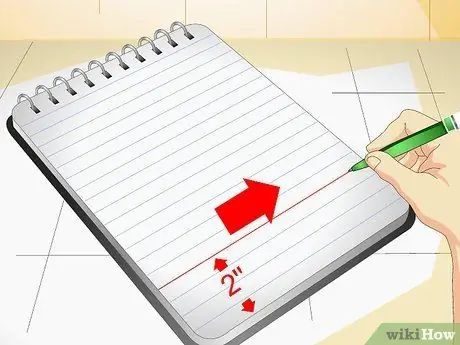
Step 2. Draw a horizontal line across the bottom of the paper
This line should be about a quarter of the way up the page, 5cm from the bottom. Later, this section will be devoted to the summary of the notes.
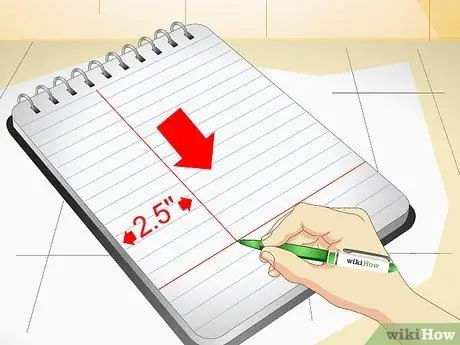
Step 3. Draw a vertical line on the left side of the paper
This line should be approximately 6.5 cm from the left edge of the page. You will use this part to comment on your notes.
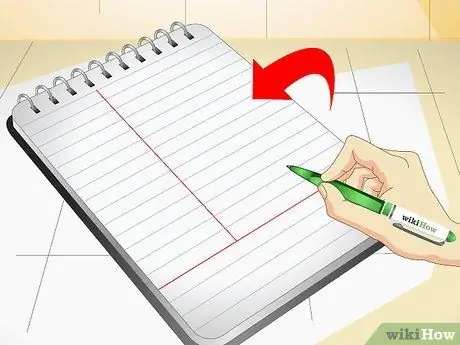
Step 4. The largest part of the page will be where you have to write your notes during the lesson
The space should be sufficient to hold all the most important points.

Step 5. If you need help, search the internet for a Cornell note sheet template
If you need to take a lot of notes or want to save time, you can find ready-made templates for this method of writing notes. Print them and follow the steps in this article to use them correctly.
Part 2 of 4: Taking Notes

Step 1. Mark the course name, date and topic of the lesson at the top of the page
Never forget to do this, so it will be easier to keep your notes organized and to review the course material.

Step 2. Write your notes in the larger section of the page
While listening to a lesson or reading a book, write your notes only in the right section of the page.
Include in your notes all information written by the teacher on the board or shown on the slides
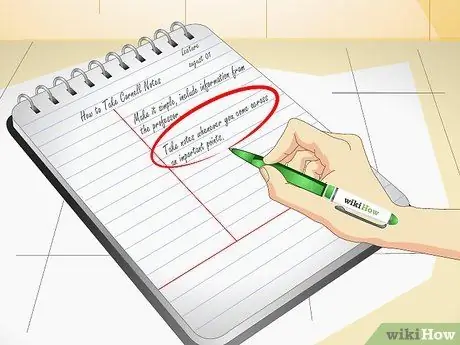
Step 3. Use your notes to actively listen or read
Whenever the professor presents a key concept, write it down.
- Look for signs indicative of important information. If the professor said "the three most important consequences of X are …", or "there are two main reasons why X happens", it would most likely be information that you should record in your notes.
- If you take notes during a lesson, pay attention to repeated or emphasized sentences, as they are probably important.
- These tips also apply to reading a text. Textbooks often quote the most important terms in bold, or repeat the information to remember in graphs or tables.
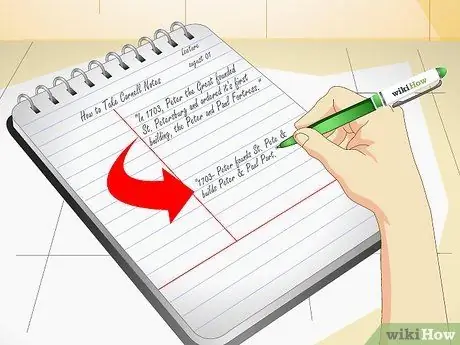
Step 4. Write simply
Think of your notes as a summary of the lesson or text you are reading. Focus on understanding the most important words and concepts, so you can keep up with what is being said; you will have time later to double check your notes and complete them.
- Instead of writing complete sentences, use bulleted lists, abbreviations (like "+" instead of "plus") and custom symbols.
- For example, instead of writing a complete sentence like "In 1703, Peter the Great founded St. Petersburg and ordered the construction of his first building, the Peter and Paul Fortress", you could simply write: "1703: Peter founds St. Peter and builds Fort. Peter and Paul ". The shortened version will allow you to keep up with what the professor is saying without missing any relevant information.

Step 5. Write down the general ideas and not the demonstration examples
Try to record the main ideas of the lesson and not all the individual examples the teacher gave to illustrate those ideas. Using paraphrases will not only help you save time and space, it will also force you to express the ideas presented in your own words, imprinting them better in your memory.
- For example, if your professor said: "For the construction of St. Petersburg, Peter hired engineers, architects, naval carpenters and other professionals from many European nations. The entry of these intellectuals and skilled craftsmen gave St. Petersburg a cosmopolitan atmosphere., fulfilling Peter's goal of making the Russian city a "window to the West", do not try to report everything word for word!
- Paraphrase the information: "Peter hired engineers, architects, naval carpenters, etc. from all over Europe; his plan: St. Petersburg =" window on the West ".
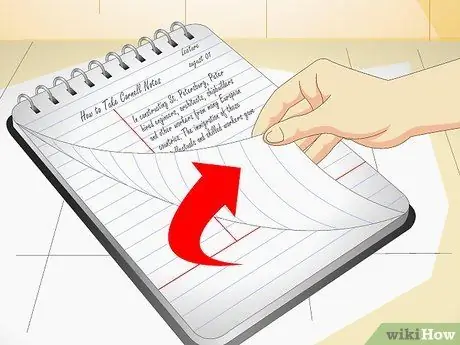
Step 6. Leave a space, draw a line or start a new page when the topic changes
This will help you mentally organize your material. It will also be useful when you have to study the different parts of the course.
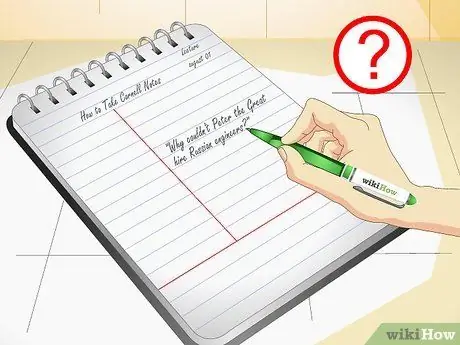
Step 7. Write down any questions you ask yourself during the lesson or reading
If you don't understand something, or want more information, you'd better write it down in your notes. These questions will help you clarify the notions you are learning and will be very helpful in reviewing.
For example, if you were taking notes on the history of St. Petersburg, you might write "Why couldn't Peter the Great hire Russian engineers?"
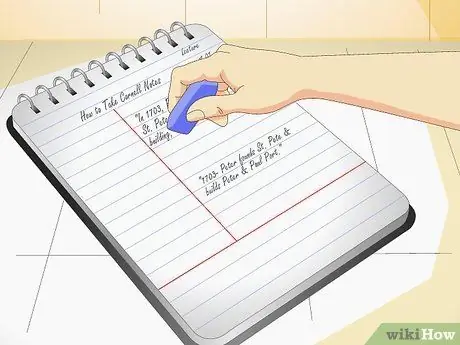
Step 8. Correct your notes as soon as possible
If there are parts that are difficult to read or that don't make sense, correct them when the topic of the lesson is still fresh in your mind.
Part 3 of 4: Correct and Expand the Clipboard

Step 1. Summarize the main concepts
As soon as you can, after class or reading, summarize the most important ideas from the section on the right. Write a very concise version of those concepts in the left column; try to insert only keywords or short phrases that summarize the salient information as much as possible. Reviewing the material within a day or so of the lesson will greatly help you remember it.
- Outlining the main concepts in the right section can help you spot them. Also try using highlighters and colors if you learn more easily visually.
- Erase unnecessary information. One of the benefits of this system is that it can teach you to identify the most important information and leave out the unnecessary ones. Practice finding concepts you won't need.
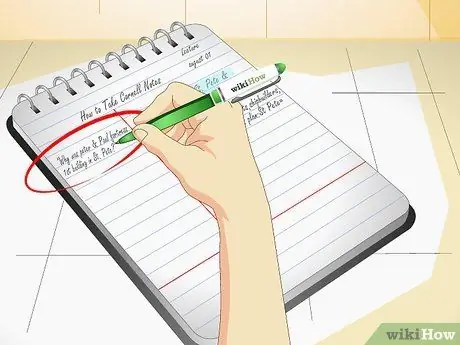
Step 2. Write the possible questions in the left column
Working on the notes on the right, think about the questions that might be asked on the exam and write them on the left. Later, you can use them as a study method.
- For example, in the section on the right, you wrote the note "1703; Pietro founds San Pietro and builds the Pietro e Paolo Fort". In the left section you could write: "Why was the Peter and Paul Fortress the first building of St. Peter?".
- You can write higher level questions, which are not answered in the clipboard, such as "Why …", or "What would have happened if …" or "What are the implications of …". For example: "What was the impact on the Russian Empire of the change of capital from Moscow to St. Petersburg?". These questions may allow you to deepen your knowledge of the material.

Step 3. Summarize the main ideas in the lower section of the page
This will help you clarify the information you have written. Rewriting the gist of the lesson in your own words is a great way to check if you understand. If you are able to summarize the notes, you are well on your way to having a clear understanding of the subject. You might ask yourself, "How would I explain this to another person?"
- Often, professors begin classes with a summary of the day's topics, for example: "Today, we will talk about A, B and C". Likewise, textbooks also often have sections devoted to summarizing the main topics. You can use these summaries as guides for your notes, and consider them alternate versions of the summary that you will need to write in the lower section of the page. Include any additional details that seem important to you or that you will need to pay particular attention to when studying.
- Usually, a few sentences will be enough to summarize a page. If necessary, include important formulas, equations, or diagrams.
- If you can't summarize some of the material, use your notes to figure out where to look for more information, or ask your teacher.
Part 4 of 4: Using the Notes to Study

Step 1. Read the notes
Focus on the left column and the summary below. These are the sections that contain the most important topics, which you will need for the exam.
If you prefer, you can underline or highlight the most important parts during the review
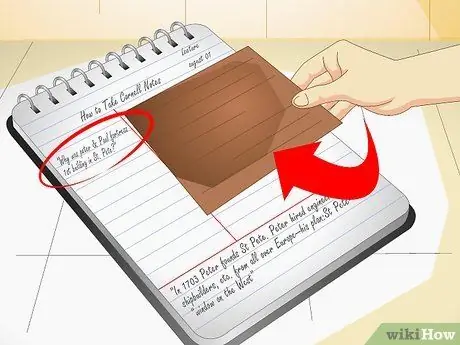
Step 2. Use your notes to test your knowledge
Cover the right side of the page (the one with the body of the notes) with your hand or another piece of paper. Answer the possible questions you have listed in the left column. Then discover the right side and check your preparation level.
You can also ask a friend to ask you questions about the notes using the left column, and you could offer to do the same for him
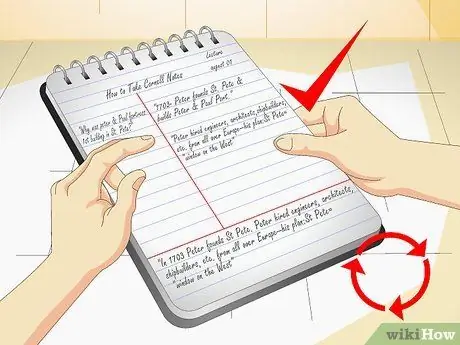
Step 3. Review your notes as often as possible
If you do this several times over a long period of time, and avoid frantically studying them before the exam, you will be able to remember the information contained more easily and you will come to a deeper understanding of the course material. Thanks to the notes taken efficiently with the Cornell method, you will be able to study effectively and with very little stress.






